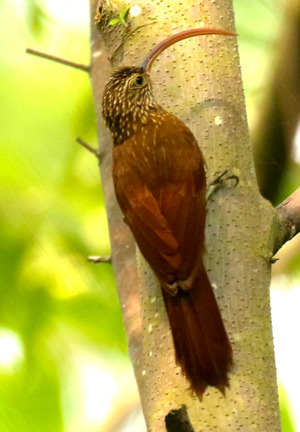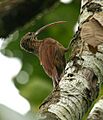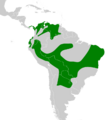Red-billed scythebill facts for kids
Quick facts for kids Red-billed scythebill |
|
|---|---|
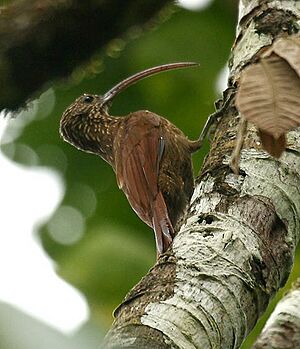 |
|
| Conservation status | |
| Scientific classification | |
| Genus: |
Campylorhamphus
|
| Species: |
trochilirostris
|
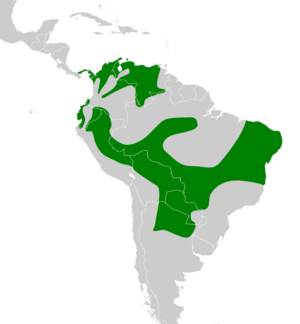 |
|
The red-billed scythebill (Campylorhamphus trochilirostris) is a cool bird that lives in many parts of South America and Panama. It's known for its long, curved, bright red bill, which looks a bit like a scythe! This bird is part of the woodcreeper family, which are birds that climb trees like woodpeckers. You can find them in countries like Argentina, Bolivia, Brazil, Colombia, Ecuador, Panama, Paraguay, Peru, and Venezuela.
Contents
About the Red-billed Scythebill Family
Birds are grouped into families and species. The red-billed scythebill is a type of woodcreeper. Scientists have found 12 different kinds, or subspecies, of the red-billed scythebill. These subspecies are slightly different from each other, often in their size or color.
Sometimes, scientists thought the red-billed scythebill was very closely related to other scythebill birds, like the black-billed scythebill. But new studies show they are not as close as once thought. It can even be hard to tell some of the red-billed scythebill subspecies apart!
What Does a Red-billed Scythebill Look Like?
The red-billed scythebill is about 22 to 28 centimeters (9 to 11 inches) long. It weighs between 30 and 55 grams (1 to 2 ounces). That's about as much as a few strawberries!
This bird is quite slim. It has a very long, thin, and strongly curved bill. This bill is usually bright red or reddish-brown. Both male and female birds look the same.
Most red-billed scythebills have a streaky face and neck. Their back is a reddish olive-brown color. The top of their head has light spots with dark edges. Their tail and flight feathers are a reddish-chestnut color. Their throat is white, and their belly is a lighter brown with streaks on the chest. Their eyes are dark brown. Their legs and feet are grayish-green. Young birds are usually less colorful and have a shorter, darker bill.
Different subspecies can have small differences. Some might be larger or have a longer bill. Others might have slightly different shades of brown or more streaks on their throat.
Where Do Red-billed Scythebills Live?
Red-billed scythebills live in many different kinds of forests and woodlands. They like places that are open or partly open. You can find them in:
- Forests with lots of trees, like the Gran Chaco woodlands.
- Forests along rivers, called gallery forests.
- Areas with scattered trees and grasslands, like the cerrado.
- Dry, thorny forests, like the caatinga.
- Smaller groups of trees in open grasslands.
- Forests that are growing back after being cut down.
In the Amazon Basin, they often live in forests that flood during certain seasons. They also like areas with tall reeds along rivers. They usually live below 1,200 meters (3,900 feet) in elevation. But in some places, like Ecuador and Venezuela, they can be found much higher up in the mountains.
Red-billed Scythebill Behavior
Movement
These birds are believed to stay in the same area all year round. They don't usually migrate to different places.
Feeding Habits
The red-billed scythebill mostly eats small insects and other creatures like spiders. They also sometimes eat tiny animals with backbones.
They usually look for food alone, but sometimes you might see two together. They often join groups of different bird species that are feeding together. They climb up and along tree trunks and branches. They mostly search for food in the middle and upper parts of trees.
They use their long, curved bills to poke into cracks in tree bark. They also search in holes in rotting wood, moss, and plants that grow on trees.
Reproduction and Life Cycle
The time when red-billed scythebills lay eggs changes a lot depending on where they live. For example, in northern Venezuela, they nest between May and July. In southern Brazil, they nest from September to November.
They build their nests inside holes in trees or tree stumps. They line these nests with leaves and other plant materials. A female usually lays one to three eggs, but most often two. Scientists don't know exactly how long the eggs take to hatch or how long it takes for the young birds to leave the nest. It seems that both parent birds help take care of the baby birds.
Vocalization
Just like their breeding times, the songs of red-billed scythebills are different depending on where they live!
- In Venezuela, their song sounds like a fast, descending "whinny."
- In western Ecuador and Peru, it's a slower series of whistled notes.
- In northeastern Brazil, their song is a short series of flute-like notes that go up at the end.
They also make many different kinds of calls.
Status of the Red-billed Scythebill
The IUCN (International Union for Conservation of Nature) says the red-billed scythebill is a species of "Least Concern." This means they are not currently in danger of disappearing.
They live across a very large area. Scientists believe there are at least 500,000 adult birds. However, the total number of birds might be slowly going down. No big threats have been found for them right now.
These birds are usually not rare, but they can be hard to find in some places, like Panama or at very high elevations. Some groups of these birds are very sensitive to human activity.
Images for kids



